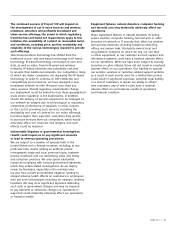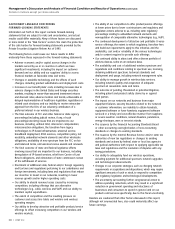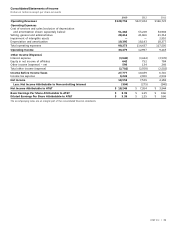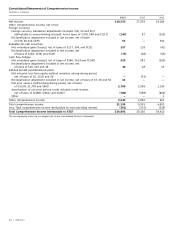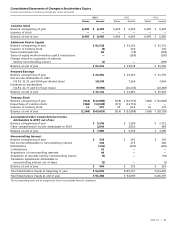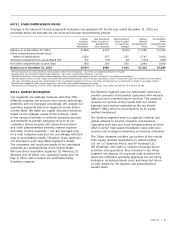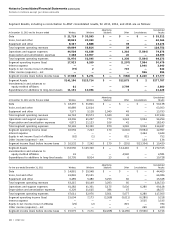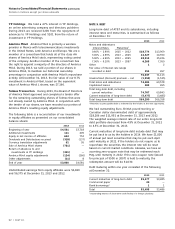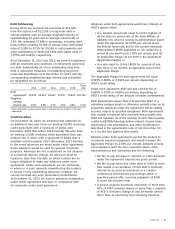AT&T Wireless 2013 Annual Report Download - page 46
Download and view the complete annual report
Please find page 46 of the 2013 AT&T Wireless annual report below. You can navigate through the pages in the report by either clicking on the pages listed below, or by using the keyword search tool below to find specific information within the annual report.
44 | AT&T Inc.
Notes to Consolidated Financial Statements
Dollars in millions except per share amounts
upon either usage (e.g., minutes of traffic/bytes of data
processed), period of time (e.g., monthly service fees) or
other established fee schedules. Our service revenues
are billed either in advance, arrears or are prepaid.
We record revenue reductions for estimated future
adjustments to customer accounts, other than bad
debt expense, at the time revenue is recognized based
on historical experience. Service revenues also include
billings to our customers for various regulatory fees imposed
on us by governmental authorities. Cash incentives given
to customers are recorded as a reduction of revenue.
When required as part of providing service, revenues and
associated expenses related to nonrefundable, upfront
service activation and setup fees are deferred and
recognized over the associated service contract period
or customer life. Associated expenses are deferred only
to the extent of such deferred revenue. For contracts that
involve the bundling of services, revenue is allocated to
the services based on their relative selling price, subject to
the requirement that revenue recognized is limited to the
amounts received from the customer that are not contingent
upon the delivery of additional products or services to the
customer in the future. We record the sale of equipment
to customers as gross revenue when we are the principal
in the arrangement, when title is passed and when the
products are accepted by customers. For agreements
involving the resale of third-party services in which we
are not considered the principal in the arrangement, we
record the revenue net of the associated costs incurred.
We offer to our customers the option to purchase certain
devices in installments over a period of up to 26 months,
with the right to trade in for a new device after a
specified period of time and have the remaining unpaid
balance waived for the original device. For customers
that elect these trade-in programs, we recognize revenue
for the entire amount of the customer receivable, net
of the fair value of the trade-in right guarantee and
imputed interest. As of December 31, 2013, total
equipment installment plan receivables of $863 were
recorded in “Accounts receivable” or “Other assets” on
our consolidated balance sheets.
Allowance for Doubtful Accounts We record expense
to maintain an allowance for doubtful accounts for
estimated losses that result from the failure or inability
of our customers to make required payments deemed
collectable from the customer when the service was
provided or product was delivered. When determining
the allowance, we consider the probability of
recoverability of accounts receivable based on past
experience, taking into account current collection trends
as well as general economic factors, including bankruptcy
rates. Credit risks are assessed based on historical
NOTE 1. SUMMARY OF SIGNIFICANT ACCOUNTING POLICIES
Basis of Presentation Throughout this document,
AT&T Inc. is referred to as “AT&T,” “we” or the “Company.”
The consolidated financial statements include the
accounts of the Company and our majority-owned
subsidiaries and affiliates. Our subsidiaries and affiliates
operate in the communications services industry both
domestically and internationally, providing wireless
communications services, traditional wireline voice
services, data/broadband and Internet services, video
services, telecommunications equipment, managed
networking and wholesale services.
All significant intercompany transactions are eliminated
in the consolidation process. Investments in partnerships
and less than majority-owned subsidiaries where we have
significant influence are accounted for under the equity
method. Earnings from certain foreign equity investments
accounted for using the equity method are included for
periods ended within up to one month of our year end
(see Note 8). We also record our proportionate share
of our equity method investees’ other comprehensive
income (OCI) items, including actuarial gains and losses
on pension and other postretirement benefit obligations.
The preparation of financial statements in conformity
with U.S. generally accepted accounting principles (GAAP)
requires management to make estimates and assumptions
that affect the amounts reported in the financial statements
and accompanying notes, including estimates of probable
losses and expenses. Actual results could differ from those
estimates. Certain amounts have been reclassified to
conform to the current period’s presentation.
Income Taxes We provide deferred income taxes for
temporary differences between the carrying amounts of
assets and liabilities for financial reporting purposes and
the computed tax basis of those assets and liabilities.
We provide valuation allowances against the deferred tax
assets for which the realization is uncertain. We review
these items regularly in light of changes in federal and
state tax laws and changes in our business.
We report revenues from transactions between us and
our customers net of taxes imposed by government
authorities in our consolidated statements of income.
Cash and Cash Equivalents Cash and cash equivalents
include all highly liquid investments with original
maturities of three months or less. The carrying amounts
approximate fair value. At December 31, 2013, we held
$697 in cash and $2,642 in money market funds and
other cash equivalents.
Revenue Recognition Revenues derived from wireless,
local telephone, long distance, data and video services
are recognized when services are provided. This is based





